PORT OF EDMONDS ENVIRONMENTAL POLICY
A Commitment to Environmental Stewardship and Innovation


The Environmental Policy Statement and Green Port initiatives were originally adopted and approved by the Port of Edmonds Commission on September 10, 2018 and later amended and approved on April 8, 2019.
The Port’s Role
The Port of Edmonds (Port) is an independently governed special purpose district established to promote and invest in economic development for the benefit of the local community. It was created by voters of the district in 1948 and is governed by a five-member board elected to four-year terms. The district boundaries encompass a portion of the City of Edmonds and all the Town of Woodway. The Port operates a marina, a boatyard, and manages commercial properties. Port activities create economic development, preserve the near shore and shoreline environment, create public access and enhance the overall quality of life for the community.
Today, the Port operates under Best Management Practices (BMPs) at all facilities, including implementing a variety of technical innovations to achieve the highest water quality standards, such as stormwater filtration to remove particulates and potential marine contamination and pressure wash water treatment.
Environmental Policy Statement
The Port is committed to protecting and enhancing the environment and natural resources of the community we serve. To this end, we have developed and follow boatyard BMPs, boatyard and pressure wash facilities wastewater treatment, and stormwater filtration and quality improvement protocols that meet or exceed requirements for discharge to receiving water, including the Puget Sound waterfront and Edmonds Marsh.
We are also committed to reducing solid and contaminated waste streams generated at the Port through a robust recycling program, strict protocols for managing solid and petroleum wastes, and best management practices in our marina, at our boat pressure wash facility, boat maintenance yard and dry stack storage facility.
We are committed to exploring and implementing reasonable additional protocols and approaches to environmental protection to the extent allowed by the regulations that govern public ports, with the goal of continuous improvement relative to environmental protection, best management practices, technical advancements, and reducing the Port’s impact to the environment, including air, water, and natural resources.
The Port of Edmonds recognizes that greenhouse gas (GHG) emissions have a negative impact on our climate with serious long-term environmental consequences. These consequences cause economic challenges relating to ecological sustainability, as well as human health concerns. We believe everyone shares the responsibility to improve energy efficiency and to reduce GHG emissions, through awareness, education and action. The Port of Edmonds supports sustainability policies and long-range planning efforts by both private and public organizations to address climate change issues, and we encourage community involvement to mitigate and reverse the direct effects of GHG on our climate, locally and far beyond our immediate ability to influence. Climate change is a global problem that can only partially be addressed at the local municipal level.
The Port of Edmonds remains committed to a long-term policy of continuous improvement in operations, methods and facilities that are economically sustainable and environmentally responsible. We are dedicated to these and other emergent responses to climate change, including reduction of GHG where feasible and practical at the Port through selection of higher efficiency motorized equipment, lighting, and Heating, Ventilation, and Air Conditioning (HVAC) equipment, as well as reducing contaminants in surface runoff.
Environmental protection is and will always be a core value of the Port of Edmonds.
The environmental protection protocols, regulatory compliance procedures, and best environmental management practices contained in the Port’s Environmental Manual that comprises the remainder of this document will be periodically reviewed and evaluated to assess their effectiveness in allowing the Port to comply with or exceed regulatory requirements and the Port’s self-imposed higher standards of environmental protection.
Integrated Pest Management Plan
1.1 GREEN PORT INITIATIVES
The Green Port Initiatives continues the Port’s existing environmental efforts and expands these efforts through continued innovation and education. The Port recognizes the importance of balancing environmental responsibility and economic goals, as well as integrating community values in Port operations. The goal of the Green Port Initiatives is to achieve long-term environmental, societal and economic benefits through resource conservation, waste reduction and pollution prevention. The Green Port Initiatives are listed throughout this document at the beginning of each section Progress is reviewed annually.
Continue, and where possible improve upon, activities and protocols that protect and enhance air, soil, and water quality at the Port.
Air
Soil
Clean-up
In 2004-05, the Port successfully removed 55 tons of residual oil-contaminated soils from its property at Harbor Square, left in place from prior industrial uses, including a fuel terminal and an asphalt plant that were in operation at the site before the Port took ownership. Some contaminated soil was left under existing buildings at Harbor Square due to inaccessibility at the time of the clean-up. Any residual contaminated soil under buildings at Harbor Square will be cleaned up when they are removed in the future.
Soil contaminated from an off-site oil release is located beneath the pavement at a portion of the Port’s dry-stack storage facility. The situation is stable, with no contamination migrating off-site. The contaminated soil under the dry-stack storage facility will be cleaned up when pavement is removed in the future.
Both sites have been rated as a 5 (lowest risk) under the Washington State Department of Ecology’s ranking of known contaminated sites.
Herbicide alternatives
During 2018, the Port enlisted Landau Associates and Pacific Northwest Pollution Prevention Resource Center (PPRC) to complete a review of its landscape program and groundskeeping chemical use. The review revealed that:
As part of our environmental protocols for 2019, the Port initiated a pilot study using alternative products and concentrations for weed control. The purpose of this study is to evaluate effectiveness of each product and determine whether these products can be cost effective and successful substitutes for maintaining Port properties in the future.
Water
Marina/Boatyard
Storm Water
The replacement of old tar-based roofing at Harbor Square with energy efficient and low-toxicity roofing material was completed in 2013, significantly reducing contaminants in storm water from the roofs. The Port has initiated phased paving repairs at Harbor Square to improve the operability and integrity of paving surfaces. The Port has installed and maintains stormwater filters in all stormwater drains on Port property, including Harbor Square and the marine waterfront.
Spill Prevention, Control and Countermeasures
Continue to maintain viable
Underwater Dives
Continue diver operations to remove debris in the Marina basin at least once per year.
Energy
Conserve and maximize energy efficiency of Port operations.
Heating, Venting, Air Conditioning (HVAC) at Harbor Square
Beginning in 2011, the Port started an HVAC replacement program for commercial buildings at Harbor Square. New units have a Seasonal Energy Efficiency Ratio (SEER) rating of 14. The older original units installed in 1982-85 had a SEER rating of 8, representing an efficiency improvement (higher rating=increased efficiency). In addition, the new replacement units use a coolant known as 410A that is environmentally much safer than the older HVAC devices that operated with FREON; hydro-chlorofluorocarbon (HCFC). FREON is known to deplete ozone in the atmosphere. The new units are approximately 50 percent more energy efficient than the old technology in the original HVAC units. As of June 2018, 62 new units have been installed, with 24 scheduled for replacement in 2019/20.
Roofing
In 2012, the Port started a re-roofing program for commercial buildings at Harbor Square using a new material known as TPO, or “thermo plastic polyolefin” that exceeds EPA’s Energy Star requirements (completed in 2013).
Lighting
In 2012, the Port replaced 98 100-watt incandescent fixtures at Harbor Square with PUD energy-efficient Energy Star LED 14.68-watt bulbs reducing the energy load by 8.36 kW, with an annual savings of 36,623 kWh.
Breakwater navigation lighting has also been replaced with LED efficient lighting.
Alternative Energy Sources
Waste Management
Reduce waste through material reuse and recycling. To facilitate successful recycling and hazardous waste disposal, ensure that signage, oversight, and communication about programs to staff, tenants, and guests is ongoing.
Recycling
Hazardous Waste
Other Programs
Environmental Excellence Certifications/Recognition
The Port has a long history of recognition by environmental excellence certification and recognition organizations, based on the Port’s record of environmental protection and practices. These recognitions include:
The Port will work to retain all currently held certifications of excellence for Port operations and continue to research and obtain certifications and recognition as operators of an environmentally superior boatyard and marina, including but not limited to EnviroStar certification.
Education
Educate staff, marina tenants, and port property guests on environmental policies and best practices through seminars, newsletters, social media, website, publications and events.
Best Management Practices (BMP’s)
Alternative products
Marina and Port Properties
The Port will continue to protect the marina waters through ongoing adherence to this policy and program requirements.
Salmon Recovery
The Port recognizes the importance of stormwater management and other factors in assisting with salmon recovery efforts.
The Edmonds Marsh
The Edmonds Marsh is one of the few urban saltwater estuaries remaining in the Puget Sound area. The marsh is currently 22.5 acres in size. It is the first stop on Audubon Washington’s Great Washington State Birding Trail – Cascade Loop and hosts up to 90 species of birds during the year. The Edmonds Marsh Interpretive Walkway includes over 300 feet of boardwalk, 1700 feet of asphalt walkway, and four interpretive stations chronicling the history, habitat and wildlife of this unique salt and fresh water marsh estuary. The walkway is used by birders, the public, and Edmonds Ranger-Naturalists leading educational interpretive programs. (http://www.edmondswa.gov/edmonds-marsh-discovery.html). The Port of Edmonds owns the north side perimeter (the boardwalk and approximately 10 feet (varies in places)) of the Edmonds Marsh, while the City of Edmonds owns the remaining.
Port staff can help you dispose of oily bilge water. This can be disposed of in the yellow bilge water container located near the oil recycling building in the boatyard. Please be aware that anti-freeze contaminates bilge water. Port staff can help you dispose of up to 5 gallons of contaminated bilge water.
Port Staff can help you dispose of up to 5 gallons of the following items:
As part of our environmental plan, we enlist Annie Crawley’s Scuba Diving Team to conduct marina cleanup dives on a regular basis. Annie and her team of talented young divers bring up trash and debris from the marina floor so that it can be disposed of properly.
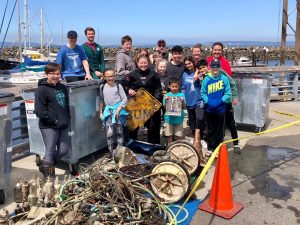
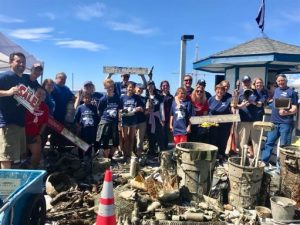
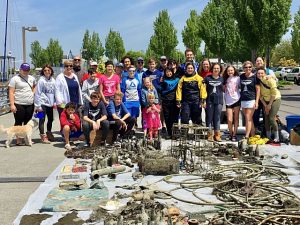
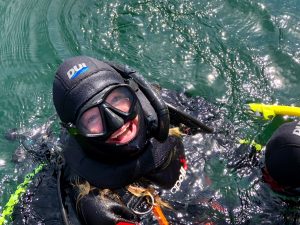

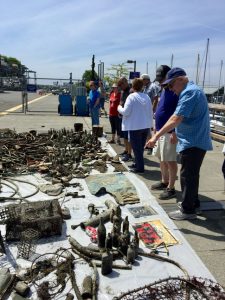
The saltwater net pen is a non-profit project designed to increase the salmon population and saltwater recreational fishing opportunities in the mid-Puget Sound region by delaying the release of salmon into the wild. The coho reared for this project are hatched and raised at the Issaquah State Salmon Hatchery each year before coming to Edmonds. After the fish are transferred into the pen at the Port of Edmonds Marina in early spring, the pen is moved down to the Edmonds fishing pier where the Washington Department of Fish & Wildlife (WDFW) supply the fish with approximately 45 pounds of food each week until they are released in June.
The Port of Edmonds is a long-time, proud sponsor of the Saltwater Net Pen Project which has been in operation since the 1980’s and was supported by members of Edmonds Trout Unlimited which also managed the Willow Creek hatchery here in Edmonds. Both volunteer projects were under the guidance of WDFW. Recently, the Sno-King Chapter of Puget Sound Anglers have taken over the management of the Saltwater Net Pen Project and continue to rely on volunteers from various groups including staff from the Port of Edmonds and longtime project volunteers.
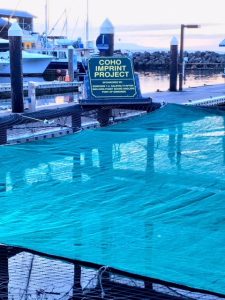
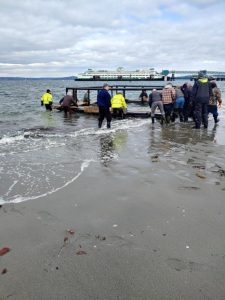
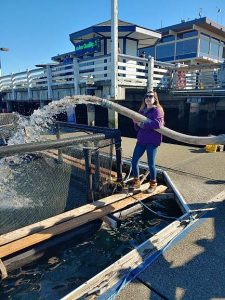
A Port of Edmonds staff member has developed an innovative filter for purifying stormwater before it reaches Puget Sound. The filter is a perforated cartridge containing crushed oyster shells that can be easily placed in catch basins. The Port has been successful in reducing copper and zinc metals by utilizing oyster shells in the trench drains of our boatyard. With this new filter cartridge, we may now be able to expand the use of oyster shells in other operational areas of the Port. The filter cartridges have been fabricated by our maintenance team and are being pilot tested in various catch basins. To establish a baseline for zinc and copper levels, water samples were taken before the filter cartridges were installed in November of 2018. Phase one monitoring, where water samples were tested and recorded, took place throughout 2019 and 2020. Phase two monitoring took place in 2021. Results indicated the filters had a positive impact on water quality; as a result, the use of the filters, paired with a parking lot sweeping program, is now an integral part of our environmental program.
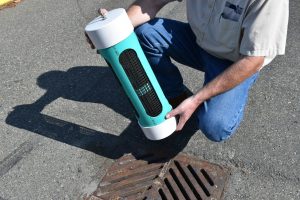
In 2019, the Port initiated a pilot study to find alternative products for maintaining our many landscaped areas throughout the facilities. The purpose of this study was to evaluate the effectiveness of a range of herbicide products and determine whether one of these products can be successful substitutes for maintaining Port properties in the future. Some of the alternate products tested during phase one in 2019 included horticulture vinegar, Rodeo, Crossbow, and Avenger. Phase two testing took place during the spring and summer months of 2020 to assess a combination of Avenger and Scythe. This combination proved to be effective and is used in very minimal quantities when an herbicide product is required. Roundup is not used on Port of Edmonds property.
A full description of our environmental-focused approach to landscaping can be found in our Integrated Pest Management Plan.

The Port of Edmonds has been awarded Leadership Clean Boatyard Certification as designated by Clean Boating Foundation.
The Clean Boating Foundation’s Clean Boatyard Program recognizes clean boatyards on two different levels: certified Clean Boatyards and certified Leadership Clean Boatyards. Clean certification comes from full compliance with all legally-required items of the checklist, which is based on the boatyard NPDES permit and hazardous waste regulations. The additional Leadership Clean certification is awarded to those yards which demonstrate a true commitment to environmental protection and are going well above and beyond the legally required items.
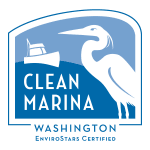
The Port of Edmonds has been awarded Clean Marina Certification as designated by Clean Marina Washington.
The Clean Marina Washington program, created in 2005 as an expansion of the EnviroStars program, helps boaters and marinas leave a healthy wake. Through this rigorous certification program marinas assess their operations and make improvements to better protect the environment. Clean Marina partners include:
– Washington Department of Natural Resources
– Washington Department of Ecology
– EnviroStars Certified
– Northwest Marine Trade Association
– Washington State Parks
– Sea Grant Washington
– Puget Soundkeeper